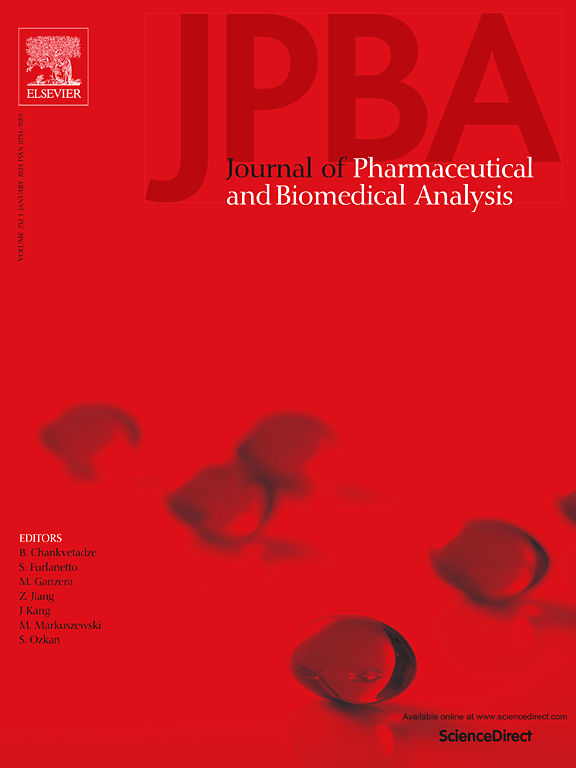Affinity-based 3D-printed microfluidic chip for clinical sepsis detection with CD69, CD64, and CD25
IF 3.1
3区 医学
Q2 CHEMISTRY, ANALYTICAL
Journal of pharmaceutical and biomedical analysis
Pub Date : 2024-10-03
DOI:10.1016/j.jpba.2024.116500
引用次数: 0
Abstract
Sepsis is a life-threatening immune response to infection in the body, eventually resulting in fatal organ failure. Current methods utilize blood cultures and quick-Sequential-Organ-Failure-Assessment (qSOFA), but there is a need for more accurate and time-sensitive diagnostic methods to improve survival rates. We present a 3D-printed microfluidic chip that bioconjugates antibodies CD69, CD64, and CD25 to channel surfaces to capture sepsis cells in blood samples and validate it with clinical samples (n = 125 septic, n = 10 healthy). Other variables were taken such as healthy volunteer blood samples and patient demographics to validate and confirm our device’s diagnostic ability. Statistical differences were found between healthy volunteer and sepsis patient antigen cell counts (CD69 p-value < 0.001, CD64 p-value < 0.004, CD25 p-value < 0.0009), and were confirmed using principal component analysis. Demographics such as length of stay, age, culture results, and need for surgery also factored into sepsis detection on a smaller scale than the antigen cell counts. The receiver operating characteristic (ROC) analysis showed an area under the curve (AUC) of 0.989, 0.988, and 0.992 for CD69, CD64, and CD25, respectively, and a combined biomarker panel of 0.997. Overall, the device performed within a shorter time frame of 4 h compared to standard blood culture tests and was validated for use in detecting sepsis in patients.
基于亲和力的 3D 打印微流控芯片,利用 CD69、CD64 和 CD25 检测临床败血症。
败血症是对体内感染的一种危及生命的免疫反应,最终会导致致命的器官衰竭。目前的方法是利用血液培养和快速器官衰竭评估(qSOFA),但还需要更准确、时效性更强的诊断方法来提高存活率。我们展示了一种3D打印微流控芯片,它能将CD69、CD64和CD25抗体生物连接到通道表面,以捕获血液样本中的败血症细胞,并通过临床样本(n = 125名败血症患者,n = 10名健康患者)进行验证。我们还采集了其他变量,如健康志愿者的血液样本和患者的人口统计数据,以验证和确认我们设备的诊断能力。健康志愿者和脓毒症患者的抗原细胞计数之间存在统计学差异(CD69 p值<0.001,CD64 p值<0.004,CD25 p值<0.0009),并通过主成分分析得到确认。与抗原细胞计数相比,住院时间、年龄、培养结果和手术需求等人口统计学因素对脓毒症检测的影响较小。接收器操作特征(ROC)分析表明,CD69、CD64 和 CD25 的曲线下面积(AUC)分别为 0.989、0.988 和 0.992,综合生物标记物面板为 0.997。总之,与标准的血液培养测试相比,该设备能在更短的 4 小时内完成测试,并通过了用于检测患者败血症的验证。
本文章由计算机程序翻译,如有差异,请以英文原文为准。
求助全文
约1分钟内获得全文
求助全文
来源期刊
CiteScore
6.70
自引率
5.90%
发文量
588
审稿时长
37 days
期刊介绍:
This journal is an international medium directed towards the needs of academic, clinical, government and industrial analysis by publishing original research reports and critical reviews on pharmaceutical and biomedical analysis. It covers the interdisciplinary aspects of analysis in the pharmaceutical, biomedical and clinical sciences, including developments in analytical methodology, instrumentation, computation and interpretation. Submissions on novel applications focusing on drug purity and stability studies, pharmacokinetics, therapeutic monitoring, metabolic profiling; drug-related aspects of analytical biochemistry and forensic toxicology; quality assurance in the pharmaceutical industry are also welcome.
Studies from areas of well established and poorly selective methods, such as UV-VIS spectrophotometry (including derivative and multi-wavelength measurements), basic electroanalytical (potentiometric, polarographic and voltammetric) methods, fluorimetry, flow-injection analysis, etc. are accepted for publication in exceptional cases only, if a unique and substantial advantage over presently known systems is demonstrated. The same applies to the assay of simple drug formulations by any kind of methods and the determination of drugs in biological samples based merely on spiked samples. Drug purity/stability studies should contain information on the structure elucidation of the impurities/degradants.

 求助内容:
求助内容: 应助结果提醒方式:
应助结果提醒方式:


